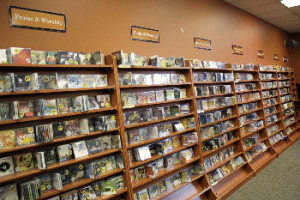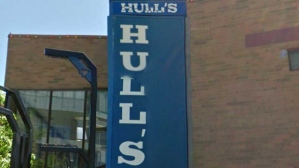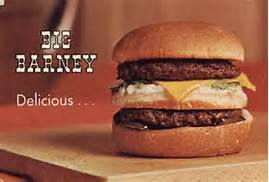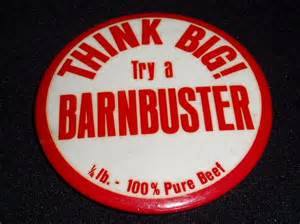 A&W is credited for popularizing onion rings after adding them to their menu in the 1960s. I make my own contribution to their continued popularity here in Thompson, Manitoba many a Wednesday evening while stopping by my local A&W for a $5.25 order of onion rings on my way between the University College of the North (UCN) Thompson campus library and Quality Inn & Suites Thompson. I could call it a pandemic takeout indulgence perhaps except for the fact I’ve been doing it since around 2015.
A&W is credited for popularizing onion rings after adding them to their menu in the 1960s. I make my own contribution to their continued popularity here in Thompson, Manitoba many a Wednesday evening while stopping by my local A&W for a $5.25 order of onion rings on my way between the University College of the North (UCN) Thompson campus library and Quality Inn & Suites Thompson. I could call it a pandemic takeout indulgence perhaps except for the fact I’ve been doing it since around 2015.
Roy Allen and Frank Wright, founders of A&W Restaurants, were very likely the first true hamburger franchisers, selling franchises in California way back in 1921. In 1956, the first A&W drive-in restaurant in Canada opened on Portage Avenue right in Winnipeg.
It wasn’t long after A&W added onion rings to their menu in the 1960s that I discovered them, thanks to my late Uncle Bob Barker, who lived in Crown Point, Indiana at the time, and introduced me to onion rings on a visit, with my Aunt Joan, and cousins Lynne and Bob, to our home in Oshawa, Ontario circa 1970. I was about 13 at the time. Uncle Bob didn’t buy our onion rings at A&W, but rather at a food truck in Lakeview Park in the south end of Oshawa on the north shore of Lake Ontario. I’ve loved them ever since
I wrote back in September 2014 here: “It is, of course, not fashionable in 2014 to offer praise of any kind for fast food. Let’s put that on our table here as a given right away. But what a satiating trip down memory lane, admittedly as guilty pleasure, it can be to recall those more modest ghosts of hamburger joints past.” Almost three years later in March 2017, I would also write here in a post headlined, “The Accidental Lowbrow Fast Food Blogger” that back in 2014, I’d never have guessed some 80,000 views and 2½ years later, how often I’d have written about food, especially fast food joints and other greasy spoons in Canada and the United States. I’m not quite sure what I thought I was going to be writing about, but I don’t remember food being on my composing radar for blog posts. Premillennial dispensationalism? The Rapture? Young Earth Creationism? Spiritual Warfare? Petrus Romanus? Prophecy of St. Malachy or Prophecy of the Popes? Any and all things Catholic? Sure, all of these and more, some pretty arcane and from the fringe of the respectable-thinking universe. But food?
An onion ring is a form of appetizer or side dish commonly found in the United States, Canada, United Kingdom, Ireland, Australia, New Zealand, South Africa, and some parts of Asia, mainland Europe, and Latin America. They generally consist of a cross-sectional “ring” of onion (the circular structure of which lends itself well to this method of preparation) dipped in batter or bread crumbs and then deep fried; a variant is made with onion paste. While typically served as a side dish, onion rings are often eaten by themselves. The cooking process decomposes propanethial oxide in the onion into the sweet-smelling and tasting bispropenyl disulfide, responsible for the slightly sweet taste of onion rings.
The exact origins of deep-fried onion rings are unknown. A recipe called “Fried Onions with Parmesan Cheese” is included in John Mollard’s 1802 cookbook The Art of Cookery Made Easy and Refined. Within the recipe, it suggests cutting onions into 1/2 inch rings, dipping them into a batter made of flour, cream, salt, pepper, and Parmesan cheese then deep-frying them in boiling lard. It also recommends serving them with a sauce made of melted butter and mustard. A recipe for onions that are dipped in milk then dredged in flour and deep-fried appeared in a 1933 advertisement for Crisco in The New York Times Magazine.
One claimant to the invention of the onion ring is the Kirby’s Pig Stand restaurant chain, founded in Oak Cliff, Texas in the early 1920s. The once-thriving chain, whose heyday in the 1940s saw over 100 locations across the United States, also claims to be the originator of Texas toast.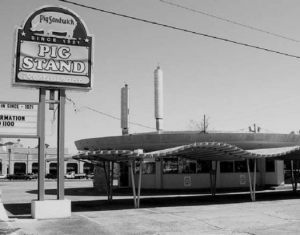
A Dallas entrepreneur named Jessie G. Kirby built the first Pig Stand along the Dallas-Fort Worth Highway in October 1921. It was a roadside barbecue restaurant unlike any other: Its patrons could drive up, eat and leave, all without budging from their automobiles. (“People with cars are so lazy,” Kirby explained, “they don’t want to get out of them.”) Kirby lured these car-attached customers with great fanfare and spectacle. When a customer pulled into the Pig Stand parking lot, teenage boys in white shirts and black bow ties jogged over to his car, hopped up onto the running board—sometimes before the driver had even pulled into a parking space—and took his order. (This daredevilry won the servers a nickname: carhops.) Soon, the Pig Stand drive-ins replaced the carhops with attractive young girls on roller skates, but the basic formula was the same: good-looking young people, tasty food, speedy service and auto-based convenience.
That first Pig Stand was a hit with hungry drivers, and soon it became a chain. (The slogan: “America’s Motor Lunch.”) Kirby and his partners made one of the first franchising arrangements in restaurant history, and Pig Stands began cropping up everywhere. By 1934, there were more than 130 Pig Stands in nine states. (Most were in California and Florida.) Meanwhile, the chain kept innovating. Many people say that California’s Pig Stand No. 21 became the first drive through restaurant in the world in 1931, and food historians believe that Pig Stand cooks invented deep-fried onion rings, chicken-fried steak sandwiches and a regional speciality known as Texas Toast.
But wartime gasoline and food rationing hit the Pig Stands hard, and after the war they struggled to compete with newer, flashier drive-ins.
You can also follow me on Twitter at: https://twitter.com/jwbarker22


